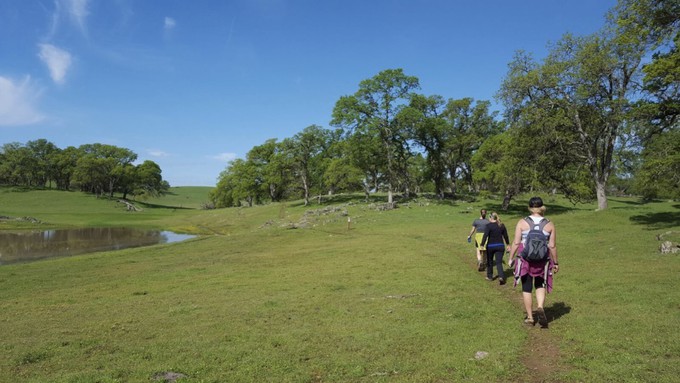
Sacramento Valley Conservancy opens trails on Saturdays

It likely won't be this sunny this weekend, but the trails are expected to be open Saturday for hikes at Deer Creek Hills Preserve. Photo courtesy Sacramento Valley Conservancy
February brings the return of hiking season to the Deer Creek Hills Preserve, one of Sacramento County's natural gems, managed by the Sacramento Valley Conservancy.
Deer Creek Hills Preserve is located off Latrobe Road in the Sloughhouse region of Sacramento County, north of Rancho Murieta. It’s a working cattle ranch that covers 4,500 acres of blue oak woodlands, seasonal creeks and grasslands. The preserve is open to the public on a very limited basis, so the hikes are one way residents can see and enjoy the county's oak woodlands in their natural state.
The self-guided hikes may be taken between 9 a.m. and 1 p.m. Saturdays, starting Feb. 4, through May, then resuming in October-November. Interested hikers must pre-register by 6 p.m. Friday and fill out a liability waiver before arriving. Admission is capped, but more than 70 tickets were still available for this Saturday as of Thursday morning.
SVC requests a $10 donation per hiker. (A season pass is available for $75.) Parking at the trailhead is free. Vehicles must cross Crevis Creek, so 4-wheel drive and other high-clearance vehicles are recommended during wet weather. Or park alongside Latrobe Road and walk the mile to the trailhead.
The preserve has three trail options:
Hikers should be hydrated and bring their own water; no running water is available at the site. Portable toilets are available at the trailhead. Wear sturdy shoes and weather-appropriate gear, and bring a cellphone. No dogs are allowed, and the SVC requests no picking of foliage, seed-gathering or other activities that would disturb the natural habitat. Snacks are allowed but no picnicking off the trails. Other conditions and limitations are listed on the hike registration site.
Through the year SVC also hosts events such as equestrian rides, Gold Rush history events and the Environmental Speaker Series. The series includes a talk on vernal pools by ecologist Carol Witham, scheduled 6-8 p.m. Thursday, Feb. 9, at Camp Pollock, 1501 Northgate Blvd., Sacramento. Registration and other information on the speaker series is here.
All events are subject to weather conditions, the conservancy notes: “Projected rain, high creek levels, extremely muddy conditions, excessive heat or unsafe air quality may cancel the outing. We will do our best to notify registered guests the evening prior via email. Please check our online calendar for cancellation postings before you travel to the preserve.”
A calendar of events is available here: https://sacramentovalleyconservancy.org/events/
– Kathy Morrison
Comments
0 comments have been posted.Sacramento Digs Gardening to your inbox.
Food in My Back Yard Series
May 6: Maintain soil moisture with mulch for garden success
April 29: What's (already) wrong with my tomato plants?
April 22: Should you stock up on fertilizer? (Yes!)
April 15: Grow culinary herbs in containers
April 8: When to plant summer vegetables
April 1: Don't be fooled by these garden myths
March 25: Fertilizer tips: How to 'feed' your vegetables for healthy growth
March 18: Time to give vegetable seedlings some more space
March 11: Ways to win the fight against weeds
March 4: Potatoes from the garden
Feb. 25: Plant a fruit tree now -- for later
Feb. 18: How to squeeze more food into less space
Feb. 11: When to plant? Consider staggering your transplants
Feb. 4: Starting in seed starting
Sites We Like
Garden Checklist for week of May 11
Make the most of the lower temperatures early in the week. We’ll be back in the 80s by Thursday.
* Plant, plant, plant! It’s prime planting season in the Sacramento area. Time to set out those tomato transplants along with peppers and eggplants. Pinch off any flowers on new transplants to make them concentrate on establishing roots instead of setting premature fruit.
* Direct-seed melons, cucumbers, summer squash, corn, radishes, pumpkins and annual herbs such as basil.
* Harvest cabbage, lettuce, peas and green onions.
* In the flower garden, direct-seed sunflowers, cosmos, salvia, zinnias, marigolds, celosia and asters. (You also can transplant seedlings for many of the same flowers.)
* Plant dahlia tubers.
* Transplant petunias, marigolds and perennial flowers such as astilbe, columbine, coneflowers, coreopsis, dahlias, rudbeckia and verbena.
* Keep an eye out for slugs, snails, earwigs and aphids that want to dine on tender new growth.
* Feed summer bloomers with a balanced fertilizer.
* For continued bloom, cut off spent flowers on roses as well as other flowering plants.
* Add mulch to the garden to maintain moisture. Mulch also cuts down on weeds. But don’t let it mound around the stems or trunks of trees or shrubs. Leave about a 6-inch-to-1-foot circle to avoid crown rot or other problems.
* Remember to weed! Pull those nasties before they set seed.
* Water early in the day and keep seedlings evenly moist.